Aug 6, 2019
WHY DOES MY DOCK SWAY?

Spring Storms
Dock sway is a result of deeper water and the need to raise your dock higher out of the water.
In 2016 we did an article about dock sway as a result of the high water that year. 2017 was worse, and 2018 continues this trend. The water depths have risen so much that each month brings new records. These records replace standards set years before many of us were born.
This year, in particular, we have experienced an unusual number of strong N.E. winds. These winds have resulted in the water depths you experience daily, to rise even further for a day or more.
These storm surges are the result of the bay being enclosed on three sides. There are limited rivers to dissipate the water at the south end when this happens. Those rivers are already at high levels and can’t dissipate more water.
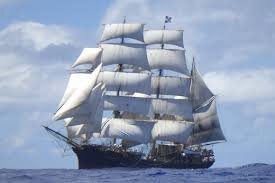
Tall Ships
Recently the “Tall Ships” came to Green Bay, and some of the ships did not have enough room under the Tower Drive bridge near the mouth of the Fox river to pass under them. They had to wait until the winds changed to enter Green Bay for their exhibition.
For more information on the Tall Ships see https://tallshipswisconsin.com/event-description/
What can PWS do about Dock Sway?
To protect your dock as much as we can, we raise your dock higher to lessen the chance of storm damage. Many of you are aware of this because the dock legs were too short to allow us to raise your dock. Our Service Manager had to contact many people to enable us to take extra time to change the legs. Our installations, which were already slowed down by frequent rain and strong winds, got even slower.
Unfortunately, raising a dock moves the center of gravity higher, and it causes the dock to “sway” when you walk on it.
Here’s an example. If you step on a 6-foot step ladder, the first few rungs are stable. The higher you go – not so much. Place your feet on the top of the ladder, and you quickly realize you are in a precarious position. (Better start looking for a safe place to land.)
ShoreMaster docks, equipped with infinity leg pockets, extend the pockets to 18″ deep versus the usual 4″ – 6″ most docks have. Angled braces are added along with the pockets. Unfortunately, even this is not enough to prevent the sway some people are incurring.
Is there another solution?
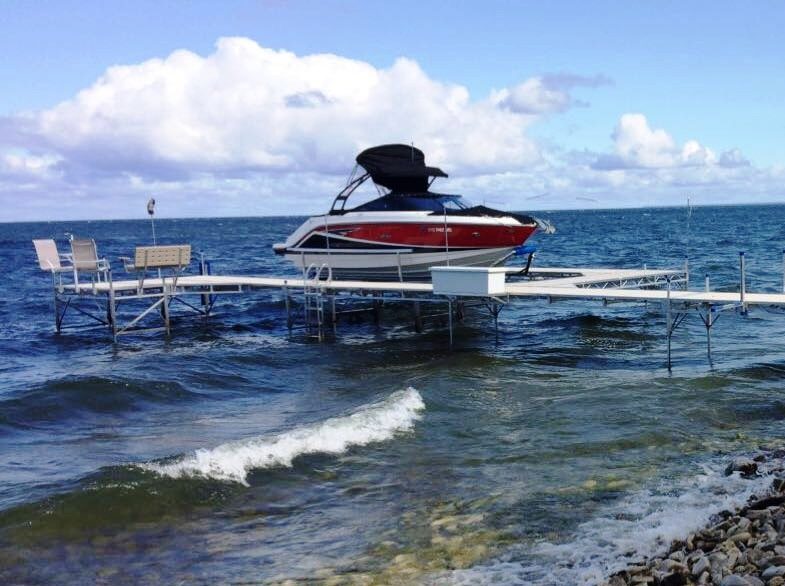
Sway brace
There is a partial solution which helps but does not totally eliminate sway – the addition of sway braces to the legs.
The addition of one or more cross-braces will reduce the swaying motion. Cross braces are rigid pipe(s) attached at an angle to the legs of the dock. For the pier to sway at the top, it must also move the opposite leg at the base where it is firmer. Mounting sway braces lessens the amount of sway you experience.
If your dock is swaying too much for your comfort, please call John, our service manager, at 920-493-4405.
For sales, contact Jerry (Jerry@wisconsinpws.com) or call 920-493-4404.
Do you have a friend that might be interested in this post? Please forward it to them.
PWS is located at 7325 St. Hwy 57. That’s 1 mile North of County MM (Hwy 42) and 4 miles South of Sturgeon Bay at the Idlewild Road intersection.
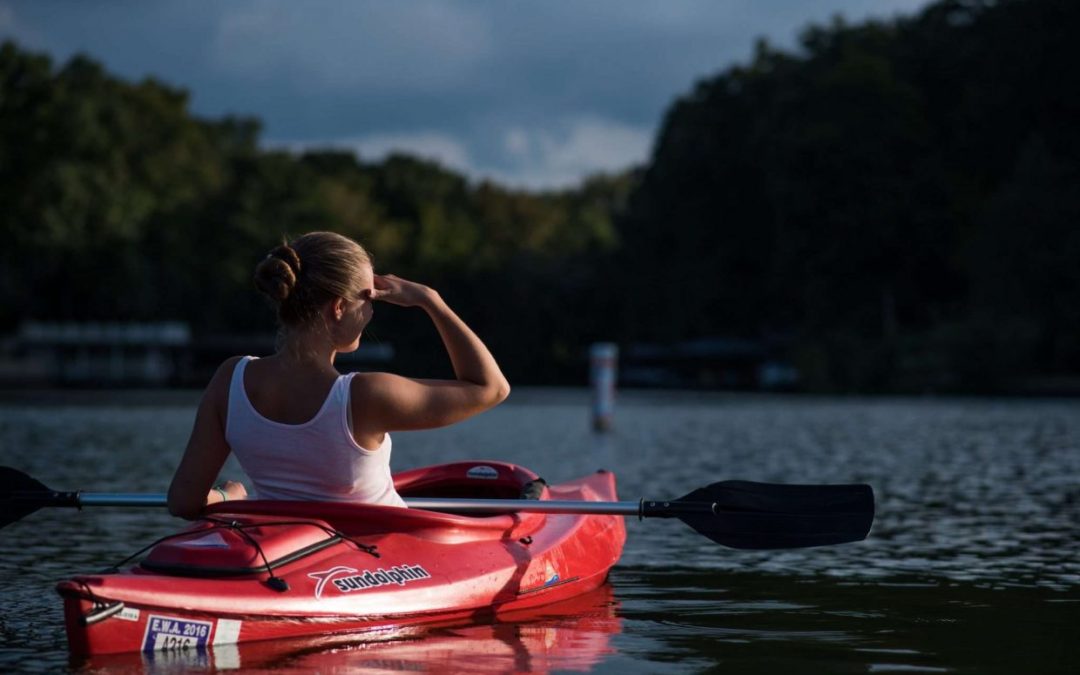
Jun 25, 2019
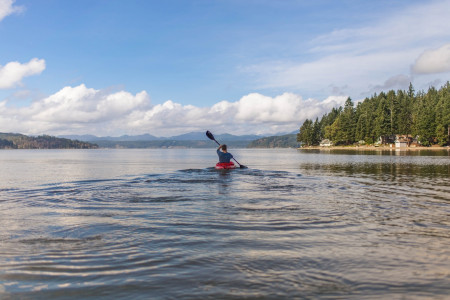
Kayaks are great exercise
Kayaks & Canoes
Kayaks & canoes are a healthy way to see more of the Door County Penninsula. Both outdoor activities provide a quiet way to relax and enjoy your surroundings. Take it from one who has tried kayaking – it is a peaceful way to spend your day. You won’t want to return to shore.
Besides paddleboarding, these two activities bring the splendor of the Door County peninsula right to you. Remember the early morning and evening panoramic views we all love so much about Door County? These are a great way to watch those sunsets and or sunrises.
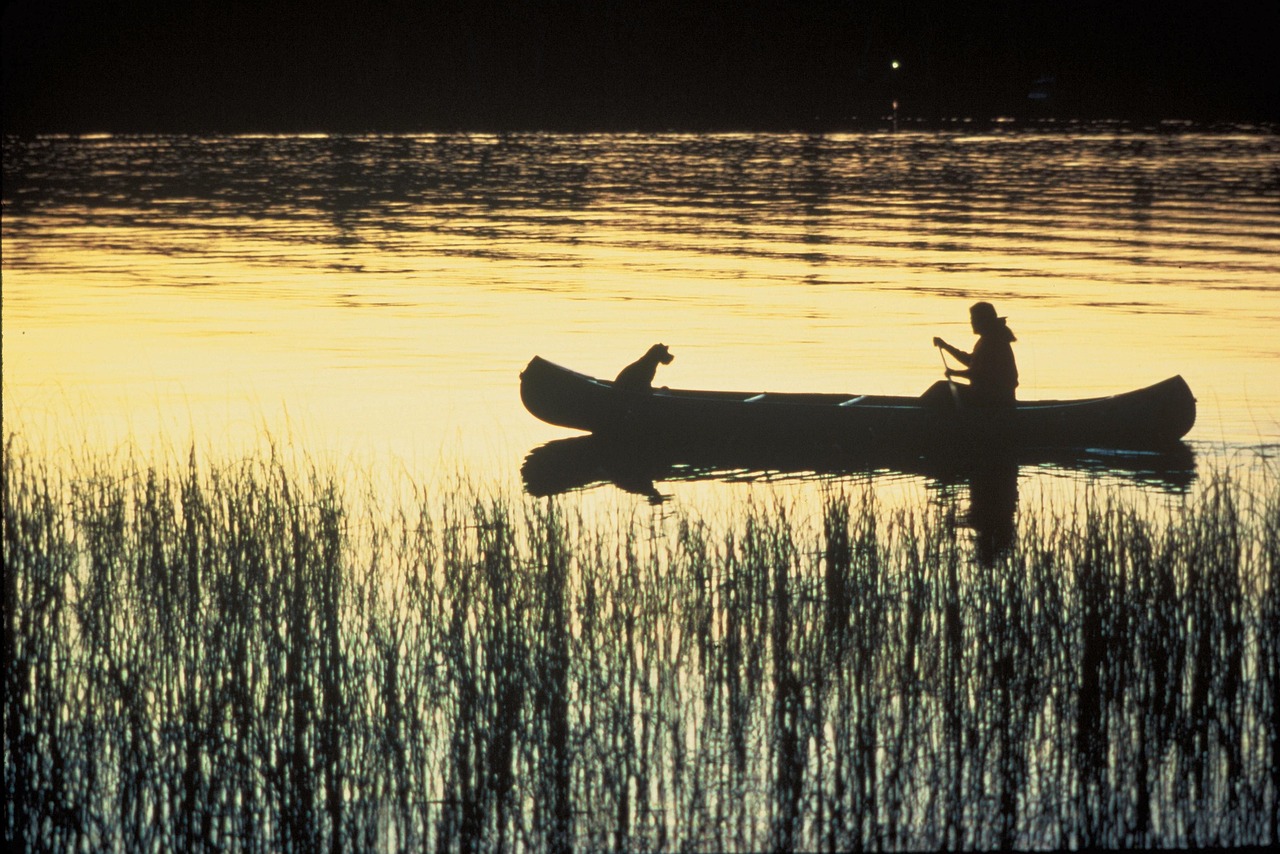
Canoeing with man’s best friend
What do you do when you return to your dock?
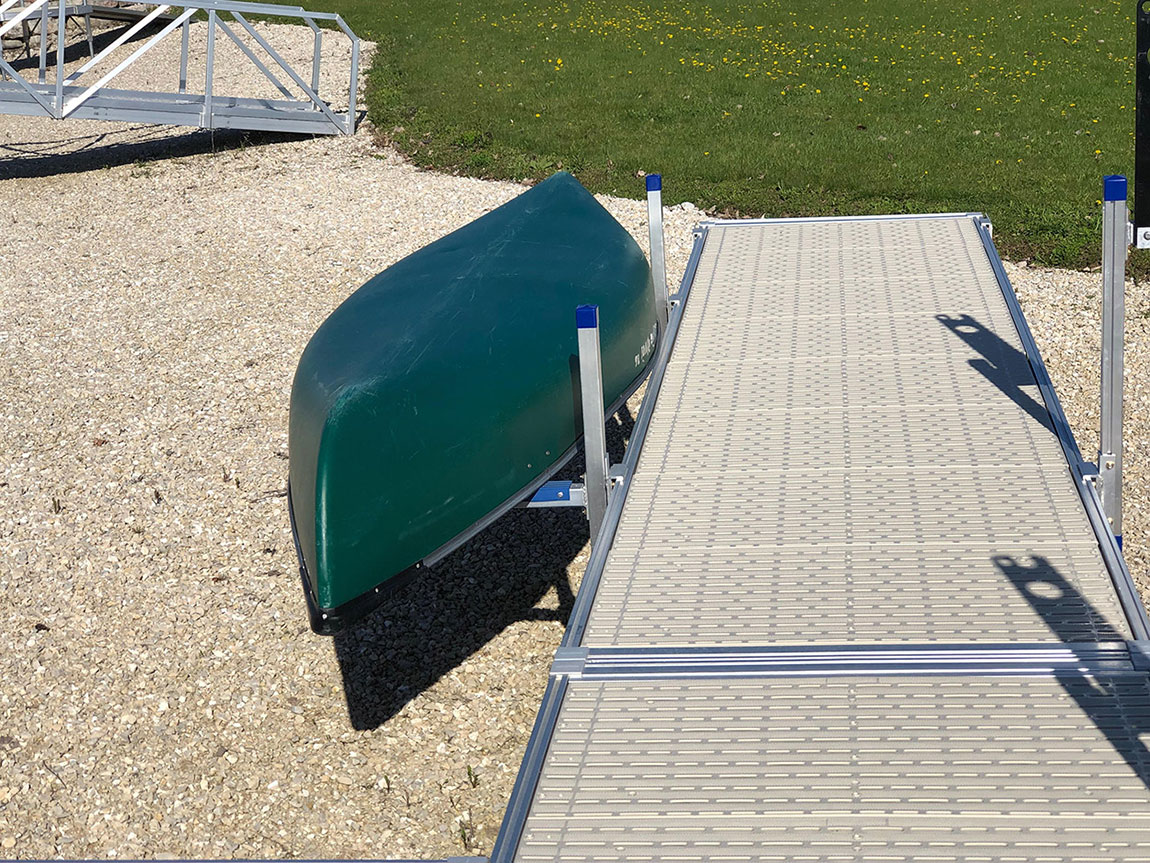
Kayak & canoe rack
What could be easier than walking to your dock and having the canoe or kayak waiting for you? By using the Canoe/Kayak racks from ShoreMaster, your equipment will be ready to go when you are.
With these easily mounted “racks” available at Pier & Waterfront Solutions, you could save a twisted ankle or sprained knee. Keep your equipment right at the dock. There is no need to walk across the rocks and risk a twisted ankle while carrying your kayak up to the house or garage.
Do you have a friend that might be interested in this post? Please forward it to them.
PWS is located at 7325 St. Hwy 57. That’s 1 mile North of County MM (Hwy 42) and 3 miles South of Sturgeon Bay at the Idlewild Road intersection. Or – you can call Jerry @ 920-493-4404 for more information.
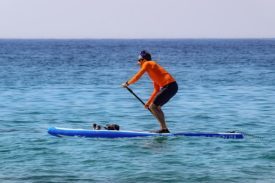
Jun 11, 2019
PADDLEBOARD
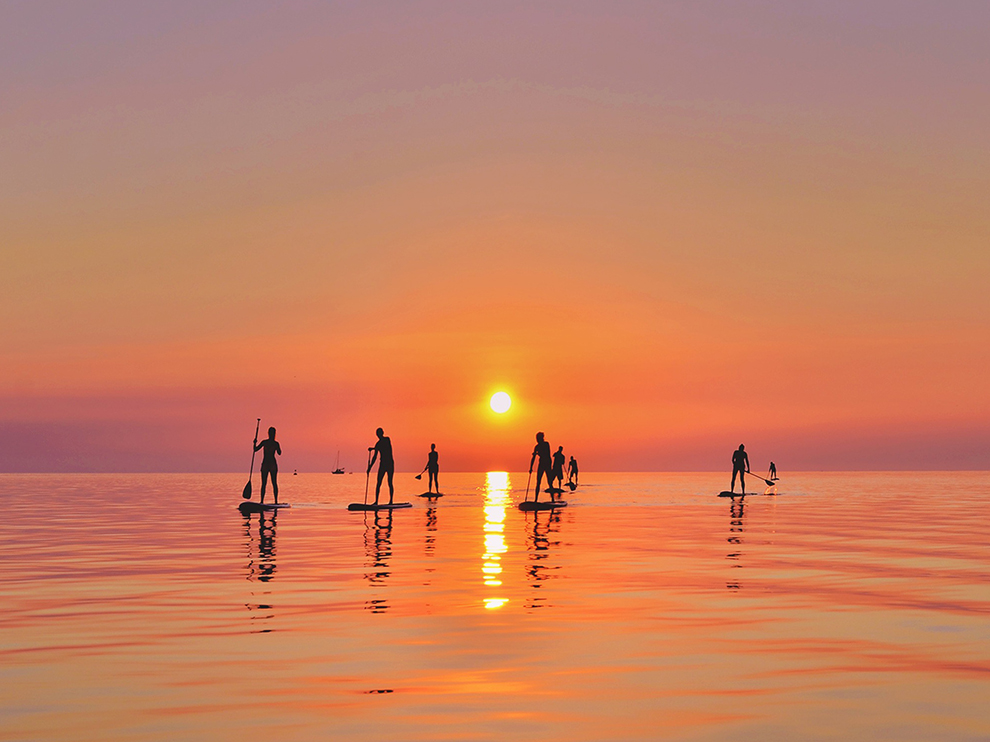
Paddleboards at sunset.
A paddleboard is becoming a favorite activity in Door County. As a great stress reliever, It also helps develop upper body strength, balance, and agility. It is a complete body workout. What people really enjoy is the peace and tranquility of the Door County Peninsula.
Just imagine the sunrises and beautiful sunsets you can enjoy on the bay of Green Bay.
What Happens When You Return to the dock?
When you return to your dock, is it cumbersome to carry your paddleboard to your house or garage each time? Don’t like taking it over the rocks on the shoreline? Don’t want to risk falling or twisting your ankle?
Do you want a way to store your paddleboard conveniently? Wouldn’t it be better to store it right at your dock securely?
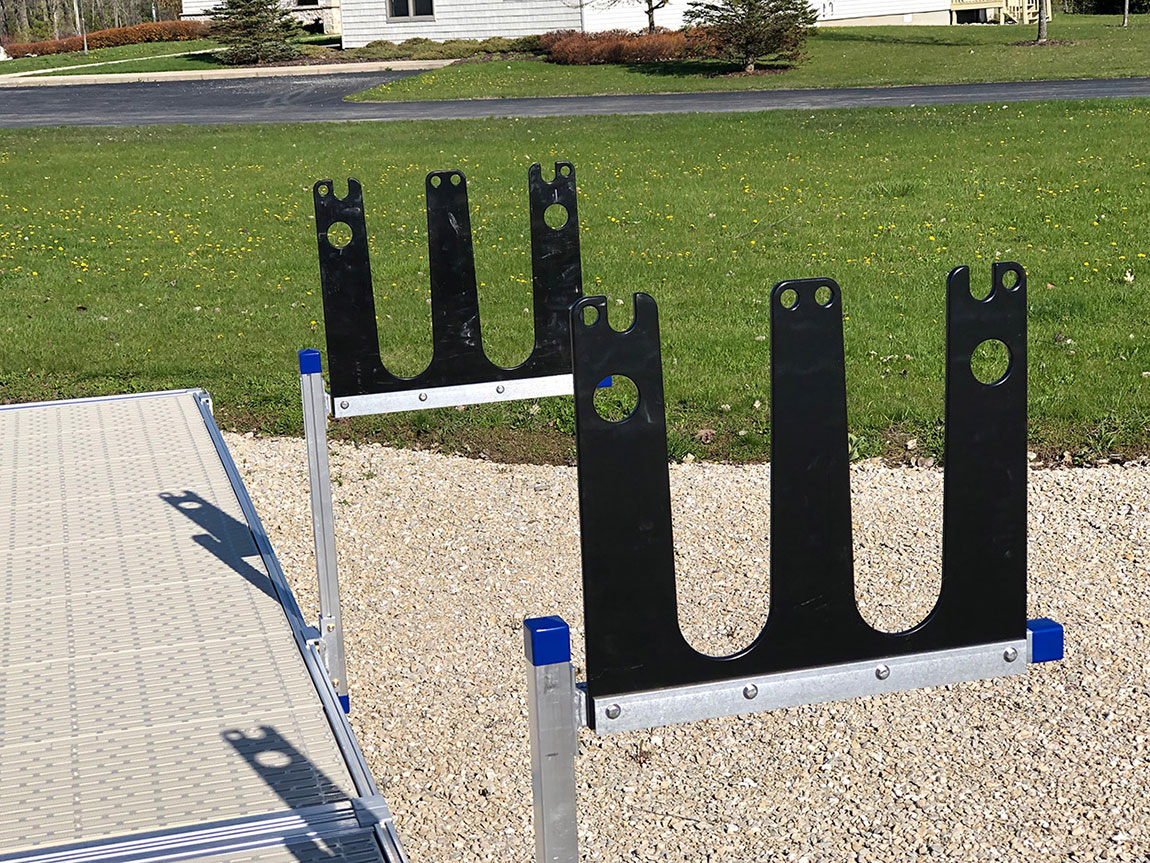
PaddleBoard Rack
Why not consider a paddleboard rack from Pier & Waterfront Solutions. The rack mounts directly to your ShoreMaster dock with ease. (The mountings adapt to other brands also.)
It’s simple to use. Place your paddleboard in the slots, and you are ready to go. Secure it and forget it. What could be simpler? The storage rack fits all paddleboards and is an attractive addition to your dock. What could be simpler?
Your board will be ready to go in an instant.
Pier & Waterfront Solutions has this paddleboard rack on display. Stop in to see it today.
Call Jerry @ 920-493-4404 for more details or to place an order. Enjoy all that the Door County peninsula has to offer.
Do you have a friend that may be interested in this information? Please share a link to this page with them.
For an excellent startup article about Paddleboarding please check this out https://www.gilisports.com/blogs/news/the-ultimate-beginners-guide-to-stand-up-paddle-boarding
Another Related article –https://www.rei.com/learn/expert-advice/paddleboarding.html
PWS is located at 7325 St. Hwy 57. That’s 1 mile North of County MM (Hwy 42) and 3 miles South of Sturgeon Bay at the Idlewild Road intersection. Our staff is here year-round to assist you.
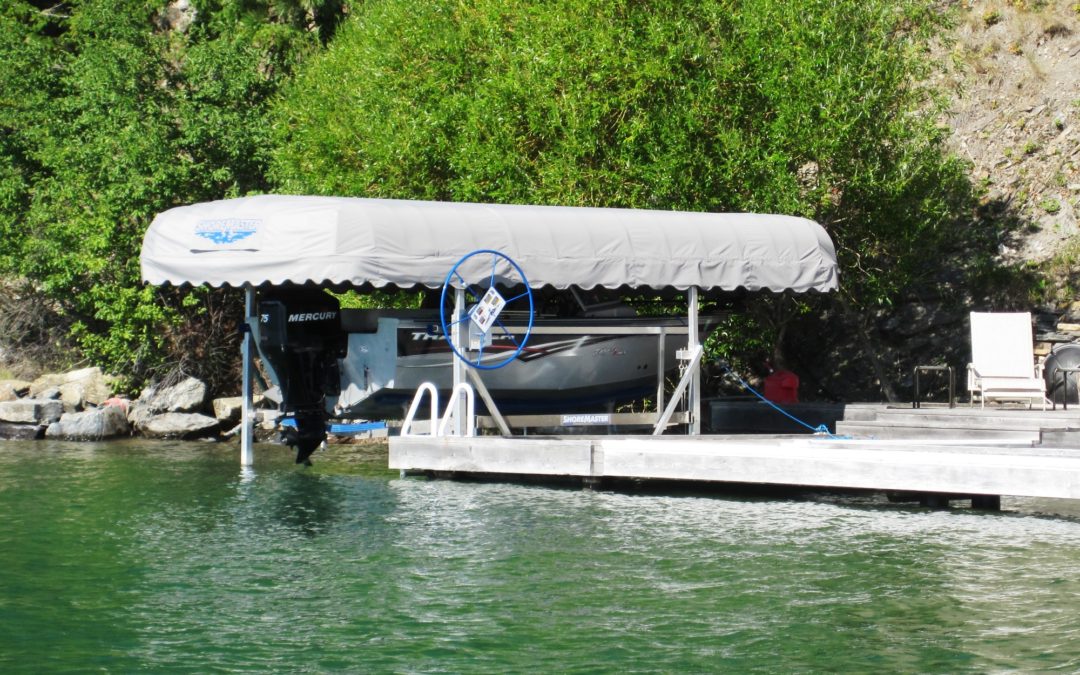
Feb 26, 2019
Boat Lift Calculations
Boat lift calculations are explained in Part 4 of this series.
Have a new boat and don’t know what boat lift size you need? We will outline the general procedure for determining the proper boat lift size to use. Much of the information we ask for can be taken from the boat registration. To give you an accurate estimate we need as much information as possible.
Finding the Overall Weight
Where can the specifications for your boat be found?
The specifications may be provided in a brochure, on a website or a specification sheet. If you can’t find them, among other resources, try using the online NADA guides www.nadaguides.com/Boats/. Go to the website, and look for “specifications” for your model and year.
Before giving you a final recommendation on lift capacities, we usually check more than one source. We always use the higher of the two numbers if there is a difference.
For this post, we went to nadaguides.com/Boats/2013/Chaparral-Boats/H2O-19-SPORT__/32036233. We selected the 2013 Chaparral Boats H2O 19 SPORT.
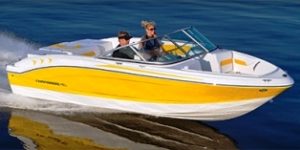
2013 Chaparral Boats H2O 19 SPORT.
The following (edited) information comes from that website.
Suncoast model weight includes the weight of the outboard motor.
[As you see below, there are (10) different engine sizes available. That means (10) different weights. Thre information is correct if they used the original motor from the manufacturer. It is best to check this information against your actual motor(s).]
115-135 HP (3.0L)
136-200 HP (3.0L – 4.3L) (included)
201-230 HP (4.3L – 5.0L ##)
231-265 HP (5.0L – 5.7L ##)
266-300 HP (5.7L #)
301-350 HP (5.7L – 8.1L ##)
351-400 HP (5.7L – 8.1L ##)
401-425 HP (8.1L ##)
426-470 HP (8.1L ##)
471-500 HP (8.1L ##)
Engine selection Key – (#) For 1993-1997 model years include 7.4L (300 HP) Mercruiser engine.
(##) Use your engine’s horsepower rating.
Under specifications, you will also find: [Condensed for our purposes]
Horsepower (bhp) 135
Length (ft-in / m) 19′ 4” / 5.9
Beam (in / m) 90 / 2.3
Dry Weight (lbs / kg) 2540 / 1152
Fuel Capacity (gal / L) 30 / 114
Please note, the dry weight provided by the manufacturer often does not account for the weight of outboard motors. Be sure you know what the number represents.
If, at any time, you would rather have PWS do the calculations for you, contact us with this information:
Model year;
Brand;
Model; and
Length of your boat.
What other items are needed for boat lift calculations?
You now have the manufacturers’ boat weight. We still need to account for:
- The weight of the fuel;
- All gear on the boat;
- Water storage;
- Non-factory additions.
Keep in mind, you will be lifting all of that weight each time your boat is raised out of the water.
IMPORTANT – EVERY boat lift manufacturer will tell you that lifts are NOT designed to transport people.
In real life, we also realize that the elderly or children often stay in the boat until it is raised. We do NOT recommend this, and you take responsibility for this action.
However, if you must take this action – allow for that added weight in your calculations. Remember, the lift can only handle it’s rated capacity. If you transport people, you are also assuming that the cables are at 100% capacity with no rust or frays. See also – https://wisconsinpws.com/lift-cable-inspection-replacement/
Now let’s look at the information provided above:
Gasoline weighs approximately 6 -7 # per gallon. Multiply this number times the capacity of your fuel tank to arrive at the weight of a full tank of gas.
Water weighs approximately 8 lbs. per gallon. Now check the capacity of all freshwater tanks, wastewater tanks and don’t forget any live wells.
Non-factory modifications – These include wakeboard towers, bimini tops, extra seating, generators, coolers, and swim platforms. It all adds up.
Gear – This include skis, wakeboards, scuba equipment, etc.
Now, add these numbers to your boat weight.
Think you’re done? Not quite yet!
Now add a “margin of safety.” This is usually between 10% and 20%. At this point, we select the next higher capacity for your lift. Why the need for all this? Here’s a simple example of why we do this.
A man picks up a ball. For our purposes, let’s say it weighs ¼ #. This presents no problem.
Next, the same ball is coming towards him at 90 mph. It hits him. It hits him. Do you think the ball “feels like” it weighs only 1/4 #? Obviously, the moving object will have the effect of “more weight’ even though it still weighs just ounces.
Why the comparison? Many times in a storm, the waves will wash against the bottom of a boat. In severe storms, the boat may actually bounce up and down on the lift as the wave rolls across the bottom. Now you have a boat weighing 2,500 – 3,200 pounds bouncing up and down. The added “weight” of the boat at this time may result in a cable breaking. This situation is especially true if the lift was not properly sized originally or the cables are not in good shape. In severe cases, the boat may be washed off the lift completely. A future post will address the insurance issue – watch for it.
Will the lift be able to take the “shock” of that bouncing? That’s why we go to the next size up. This is a common cause of cable failure. These “shocks” could cause a cable to break if they have rust or frayed strands. For more information SEE https://wisconsinpws.com/wp-admin/post.php?post=404&action=edit
The initial extra fee is small in comparison to the cost of damage to the lift or your boat. You could lose your boat & motor completely.
Do I need more Information?
What other things adversely impact a boat lift? What if your boat is in a downpour without a canopy or cover? Did you remove the drain plug while the boat is on the lift? (Don’t forget to replace it before you lower the boat).
What if you don’t know that the bilge pump is malfunctioning. These things may result in lift failure. A safety margin and a few extra dollars now may save you a lot of $$$$ later.
The point is that little things can add up and it is best to err on the side of caution.
What’s next?
The next step is to look at your boat WIDTH. In our example, we have a 90” width.
Does this mean a 96” width lift will work for you? Not even on a calm day!
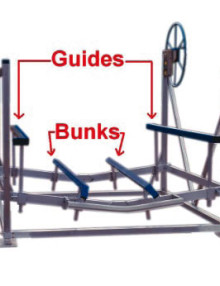
Bunks & Guide options
We equip our boat lifts with guides to keep you centered on the bunks as shown in this example. The guides require a minimum of 6” width each – that’s 12” for a total of 102” in this example. Ok, so a 108” lift will work – right? Wrong!
If you have deep water, you can maintain control of your boat on a calm day. You might be able to get by with a 108” wide lift. However, what if the wind is blowing from the back or one side? Can you control your boat under with only 6” of “spare room”?
In shallow water, you have to “trim” (raise) the motor. Shallow water is the usual situation on the bay of Green Bay. When you trim your motor, you lose control of the direction and speed you are entering the lift. Any decent wave will push you to one side. How many days are absolutely calm?
We are going to cover this situation in more depth in an upcoming post but for now, follow our recommendation for a 120” width. This width will do three things for you:
1. Allow the “guides” to place you properly on the lift;
2. Reduce the risk of damage to your boat and dock; and
3. Give you a higher resale value.
We never have a complaint about the lift being too wide
IS YOUR BOAT CENTERED?
Although not part of the equation – is your boat centered width-wise? Failure to do so will put added strain on the cables on one side. The lift ratings are based on equal weight distribution on all of the cables.
Don’t forget – you need to correctly place your boat “forward” on the lift also. If it is too far forward or back, you have too much weight on the front or rear cables. You risk breaking a cable. The weight has to be distributed equally on the front and rear cables. In a storm, this can also be a factor in your boat being washed off the lift despite being in it’s highest position.
What happens when the boat is too far forward or backward? For more information See https://wisconsinpws.com/wp-admin/post.php?post=1944&action=edit
After all this, you now have the proper lift capacity and the correct width. That about sums it up.
By the way – What would be our recommendation for this example – a ShoreMaster vertical boat lift – SM4010 DVS. (4,000# capacity, 120” wide).
Happy Boating!
Need Help Selecting a Boat Lift For Your Home or Cottage?
Do you have a friend that may be interested in this information? Please share a link to this page with them.
PWS is located at 7325 St. Hwy 57. That’s 1 mile North of County MM (Hwy 42) and 3 miles South of Sturgeon Bay at the Idlewild Road intersection.
Our staff is here year-round to assist you.
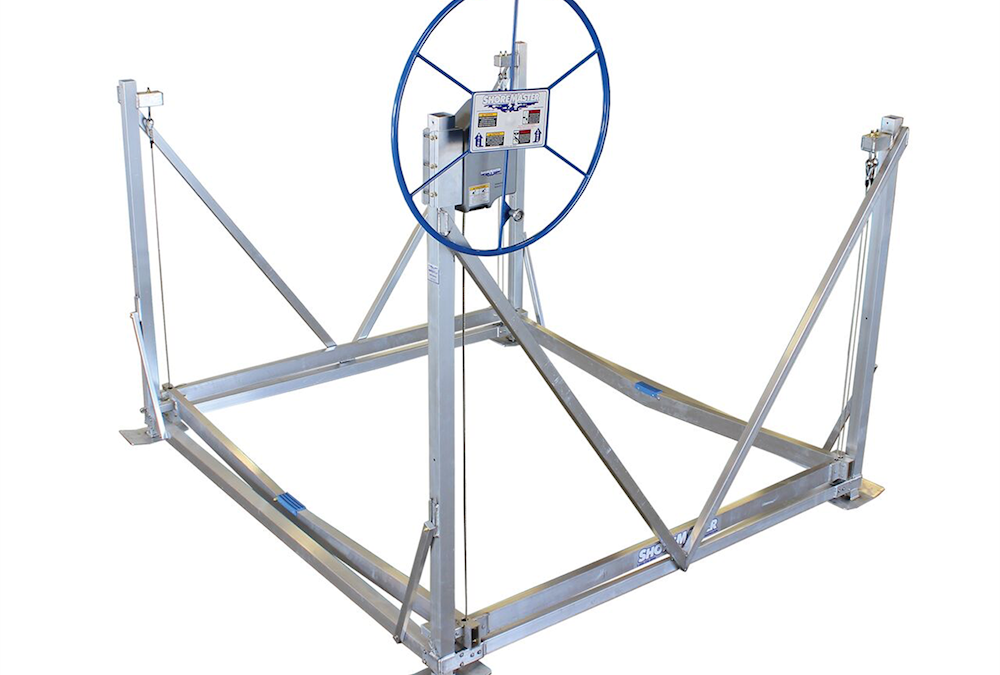
Feb 19, 2019
WHAT SIZE BOATLIFT DO I NEED?
What size boatlift do you need? Purchasing a new boatlift does not have to be a confusing time. Yet, you have a lot to consider before making your final decision. By spending a little time here, you will be better educated and able to ask the right questions. Ultimately it will ensure you make a better choice.
In addition to getting the numbers, here are some things to consider:
How big is the body of water you will be on?
For instance, will you be on the bay of Green Bay, Lake Winnebago or are you on an inland lake or river? In general, the larger the body of water, the larger the waves will be and the higher your boat must be.
Are there significant fluctuations in water depth during the boating season?
Green Bay and Lake Winnebago present unique situations for boaters because these two bodies of water have substantial variations in water depth and wave action every year. Why are these fluctuations so significant?
When these two situations combine, you want a lift that puts your boat well above the water, so your investment is safe.
How about the boatlift frame construction?
You need a durable frame construction to withstand the boat weight and pressures from the waveWelded side frames prevent any lateral movement in the lift. With age, every time you put your boat on them, bolted side frames move laterally. This will eventually result in enlarged bolt holes, rusted bolts, and loose nuts from the movement of the side frames.
Welded Areas on Side Frames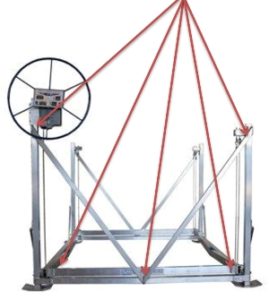
Compare to other manufacturers
Most brands use bolts everywhere, so shipping is less expensive. The more bolts used in the side frames, the weaker the entire structure is. By comparison, the ShoreMaster boatlift with welded side frames prevents lateral movement.
Only ShoreMaster boatlifts have a welded “V” frame to make access to your boat easier. You do not have to crawl over a horizontal bar to get into your boat.
What is the gauge (material thickness) of the Frame?
The best-constructed boatlifts have aluminum, welded frames using heavy gauge, square or rectangular aluminum. Round vertical legs are not as strong as a square or rectangular leg. As a result, with structurally welded frames and the heaviest gauge tubing, you have the most durable frames possible. We urge you to compare ShoreMaster lifts with any other brand.
What material is used for the pulley?
No matter what size boatlift you purchase pulley material is a critical maintenance issue for any boatlift. Most manufacturers use plastic pulleys because they are cheaper to make. On the other hand, they get brittle over time. The sides of the groove tend to crack and break off allowing the cable to fall out of the pulley. If the cable is already weakened due to rust or broken strands, the cable may break.
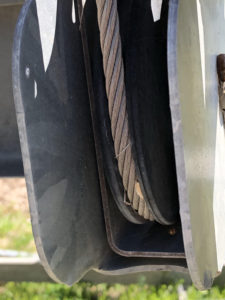
Plastic Pulleys
However, if the cable does not break, two things can happen:
- The cable may jam between the pulley and the tube side. As a result, it will become very difficult to raise or even lower the boat. or
- The cable may drag across the pulley shaft. This will put an excessive drag on the cable and eventually wear a groove in the shaft until it breaks the shaft off.
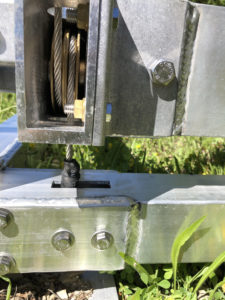
Brass Pulleys
ShoreMaster uses brass pulleys with stainless steel bushings for unsurpassed strength. They simply NEVER wear out or break. Even the smaller jet ski lifts use brass pulleys to minimize maintenance issues.
What is the most popular boatlift used on the Door County Peninsula?
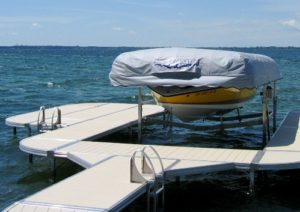
Vertical Boat Lift
The VERTICAL boat lift is the most popular boat lift in Door Couty. It far surpasses the cantilever boatlifts used in the past.
Vertical boatlifts require less water – 6″ vs 12″. They also raise your boat higher. Normal cantilever boatlifts raise your boat 36″ – 40″ high versus a vertical lift which goes to 66″ high. Vertical lifts have capacities up to 7,000 lb.
What is the warranty of the boatlift frame?
Some boatlifts come with a 1 or 2-year factory structural warranty. Some have a five year, and a few have a 10-year warranty. ShoreMaster boatlifts carry a full 15-year structural warranty.
Don’t you deserve the best protection and strength of a ShoreMaster Boatlift?
In Part 4 of this series, the discussion will be the actual calculations to select the correct size boatlift.
Publication Dates
Part 1 of 4 – Cantilever, PWC, ShorePorts, Tracks Feb 5, 2019
2 of 4 – Hydraulic, Elevator Lifts, Floating lifts Feb 12, 2019
3 of 4 – Vertical lifts Feb 19, 2019
4 of 4 – Calculations Feb 26. 2019
Do you have a friend that may be interested in this information? Please share a link to this article with them.
PWS is located at 7325 St. Hwy 42/57, that’s 1 mile North of County MM (Hwy 42) and 3 miles South of Sturgeon Bay at the Idlewild Road intersection
Our staff is here year-round to assist you.























